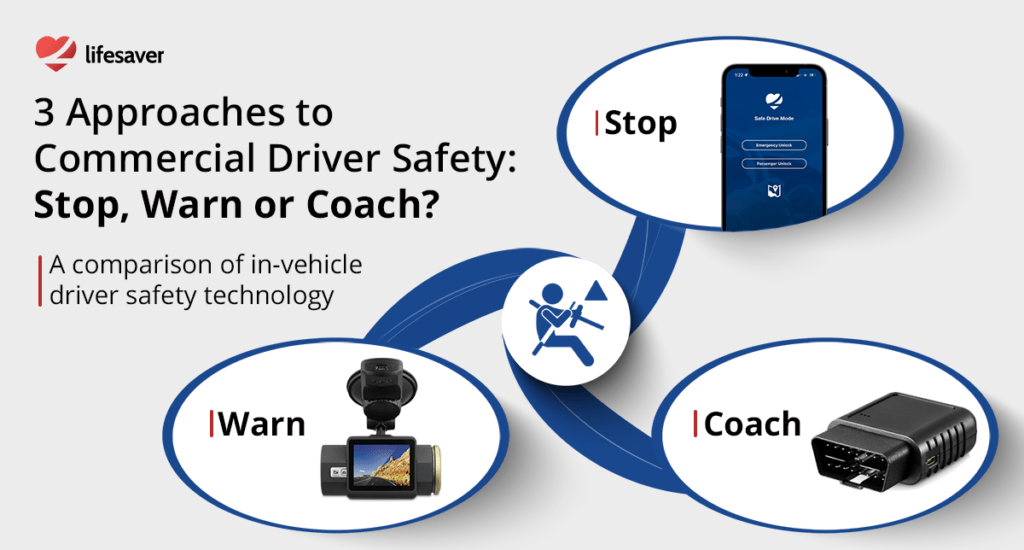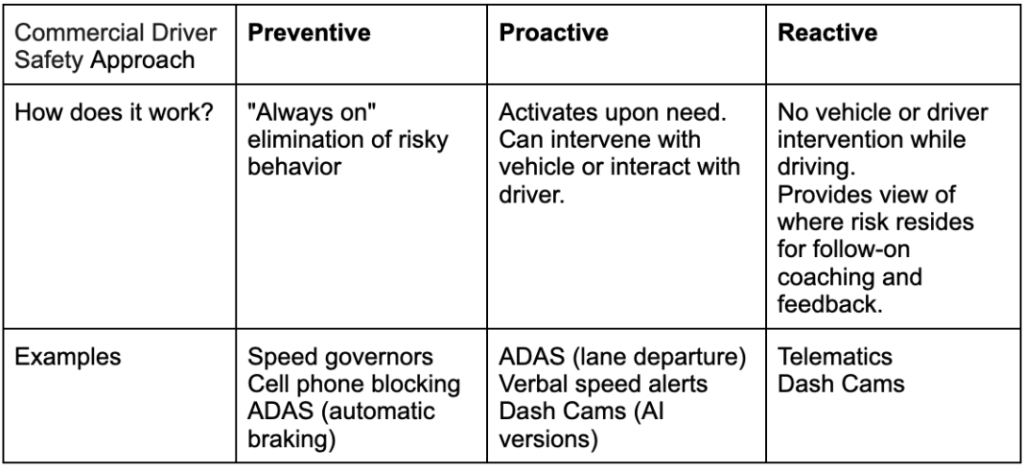A comparison of in-vehicle driver safety technology
“True prevention is not waiting for bad things to happen, it’s preventing things from happening in the first place.”
– Don McPherson, former NFL quarterback
With increasing accident rates, increasing accident settlement costs, and more expensive adverse legal judgments, fleets are doing what they can to improve driver and vehicle safety with the goal of cutting down on accidents.
Commercial driver safety technology includes solutions that may block a risky driving behavior, interact real-time with the vehicle on risky conditions, interact near real-time with the driver on risky conditions, or summarize risky driving through back-end reporting.
These technologies address fleet driver safety in different ways, either by preventing the problem, providing a proactive approach to the problem, or providing a reactive framework to address the identified risky driving behavior.
Preventive Commercial Driver Safety
Blocking of behavior–two examples of blocking are speed governors on vehicles or cell phone blocking. Try to drive over speed with a governor in the vehicle and you can’t do it. Try to use a blocked phone and you can’t use it (although it is possible to override the blocking when needed). These driver safety technology approaches stop risky driving behaviors when correctly implemented.
Proactive Commercial Driver Safety
Intervention with the vehicle while driving–ADAS Interaction with the vehicle–this technology will recognize things like a pending collision or lane departures and take over control of the vehicle to provide “active braking” (to avoid a collision), or correction for lane drifting. ADAS technology is available in most commercial vehicles, is widely available as a standard feature on newer cars, and will become the core safety approach of future driverless vehicles.
Near real-time intervention with the driver–this driver safety technology recognizes a risky situation and notifies the driver of the issue. Unsafe following distance, excessive speeding, and driver distraction are typical behaviors that can generate real-time verbal (or audio) feedback to let the driver know that this behavior is risky and should be corrected. This technology may be included in pure fleet telematics (OBD, black box) solutions as beeping signals to the driver. It is also commonly provided with AI-oriented fleet dash cams that recognize risky behaviors and provide near real-time verbal corrective feedback to the driver.
Reactive Commercial Driver Safety
Back-end reporting provides identification of elements of driving risk that can be used for feedback and coaching to drivers. These types of reactive solutions do not intervene with the vehicle or the driver with the focus being on providing back end reporting for driver correction through coaching and fleet driver safety training. Reporting directly to the driver allows for self-correction, whereas reporting to management provides oversight regarding continuing problem drivers.
Challenges with Fleet Driver Coaching
While many solutions provide feedback to management regarding unsafe driving behaviors, a reliance on effective coaching and commercial driver safety training is problematic for several reasons:
- Namely, fleet driver coaching is hard to do, discussing negative behaviors with drivers.
- Secondly, management must maintain a consistent focus over time to coach. Fleet driver safety training programs become stale over time. The feedback program must be kept interesting and evolving for continued driver engagement.
- Geographic consistency must be applied to running a coaching-centric program. It is often experienced that coaching-centric programs are managed with a different level of commitment across different geographies.
- Management has little extra time for the labor intensive process of interaction with drivers.
- Even with the opportunity for self-correction, there will be drivers who just don’t respond and ultimately management must have oversight of the program to provide coaching/corrective guidance to outliers.
- The bottom line is that commercial driver safety technology can positively impact driver safety without management intervention. Proactive and reactive approaches to safety both ultimately need to provide feedback to drivers/management based on identified driving risk, but the reactive approach relies purely on the effectiveness of the fleet driver safety training program—whereas the proactive approach (real-time intervention with the vehicle or the driver) seek to either eliminate the risky behavior or give the driver the chance for immediate correction.
Commercial Driver Safety Tips: Which Approach is Best?
In thinking about and implementing a commercial driver safety program, the more that safety technology can completely stop risky driver behavior, the better (like speed governors) in terms of pure effectiveness. Driver safety technology that can actually step in and eliminate the risky situation (like active braking) while it is happening is the next most effective. Technology that can identify in near real-time the offending behavior and notify the driver for self correction is the next most effective. Least in terms of effectiveness is a reliance on the reporting to management/safety of identified risky behaviors leading to driver feedback and coaching.



